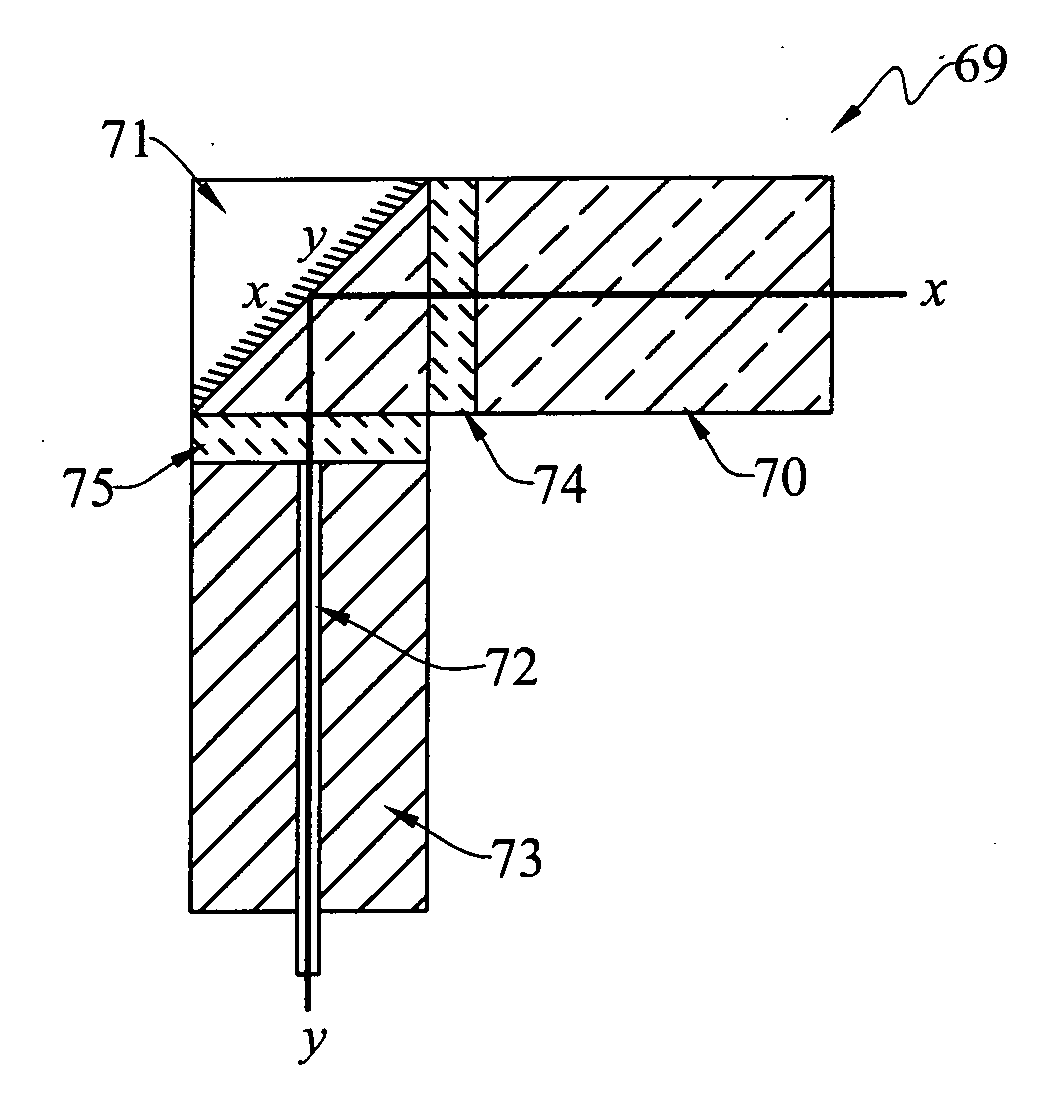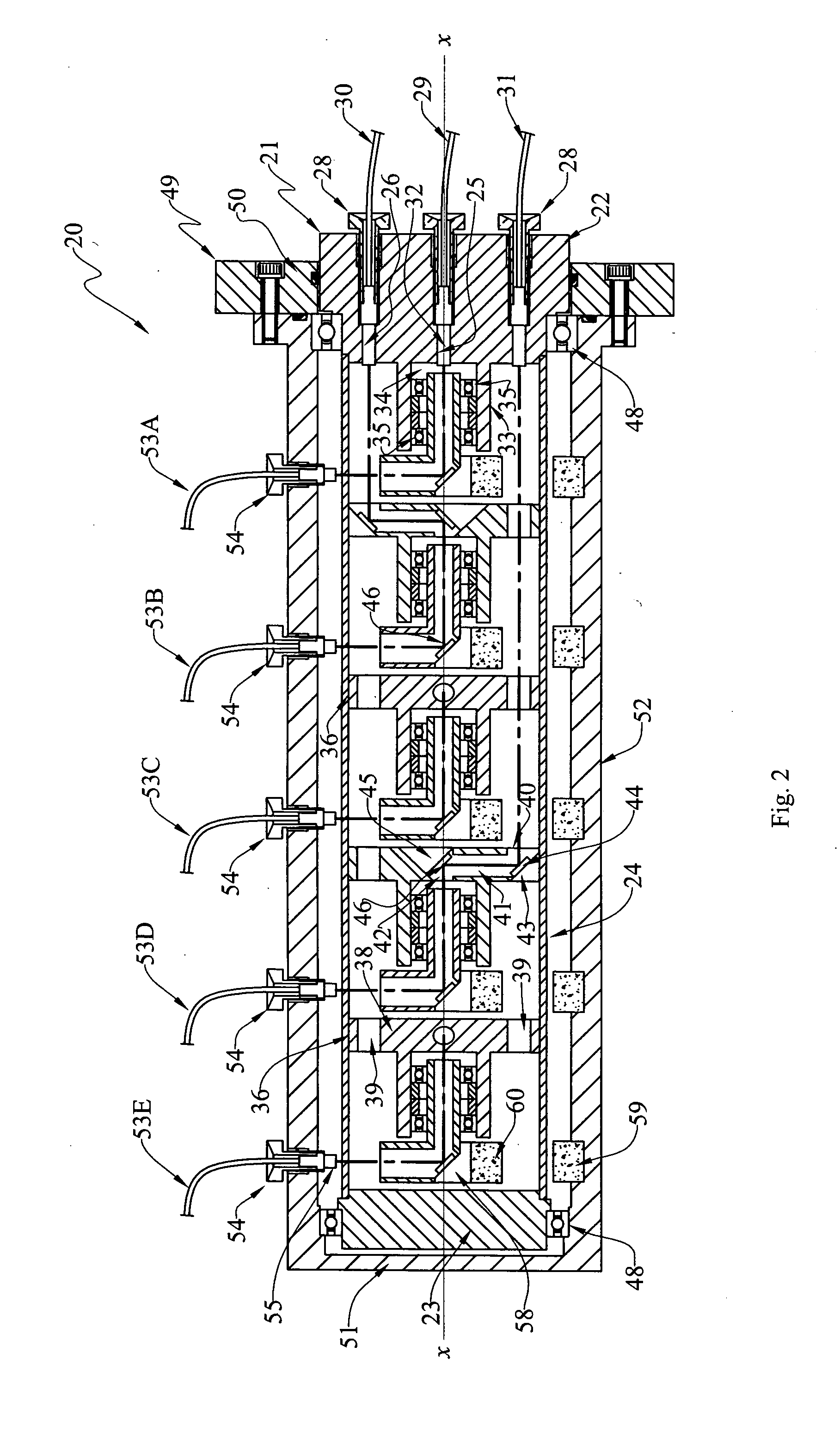Low-loss collimators for use in fiber optic rotary joints
- Summary
- Abstract
- Description
- Claims
- Application Information
AI Technical Summary
Benefits of technology
Problems solved by technology
Method used
Image
Examples
first embodiment
FIGS. 3A-3D
[0078]Referring now to FIG. 3A, a first embodiment of the present invention provides a radially-symmetric short-pitch collimator, generally indicated at 61. This collimator includes a short-pitch gradient-index rod lens 62 secured to one end of a cylindrical glass spacer 64 via an intermediate optically-transparent epoxy 63. The other end of the spacer is secured to a fiber / ferrule subassembly via an intermediate optically-transparent epoxy 65. The fiber / ferrule subassembly is shown as having an annular ferrule 66 surrounding the right marginal end portion of an optical fiber 68. This fiber may be either a multimode or singlemode optical fiber
[0079]In FIG. 3B, the short-pitch gradient-index rod lens 62 is shown as being a horizontally-elongated cylindrical rod-like member having a horizontal axis x-x, a spacer-side left end 62a, a right end 62b, a spacer-side focal plane 62c, and a right focal plane 62d. The ends 62a, 62b may be oriented either perpendicularly to the opti...
second embodiment
FIGS. 4A and 4B
[0086]Referring now to FIG. 4A, a second embodiment of the present invention, generally indicated at 69, comprises an axially non-symmetric short-pitch collimator suitable for use in a fiber optic rotary joint requiring fiber ingress oriented at right angles to the rotation axis of the rotary joint, or for use in applications where size restrictions prevent the use of an axially-symmetric collimator and bending of the fiber to a right angle ingress. The second embodiment is comprised of similar subcomponents to the first general embodiment described in FIG. 3A. Thus, collimator assembly 20 includes a short-pitch gradient-index rod lens 70, a right-angle cube reflector prism 71 (which replaces the glass spacer of the first embodiment), and the fiber / ferrule subassembly comprised of the optical fiber 72 within a ferrule 73. The left end of lens 70 is secured to the right face of prism 71 by means of an optically-transparent epoxy 74. Similarly, the upper end of the fibe...
third embodiment
FIGS. 5A and 5B
[0092]Referring now to FIG. 5A, a third embodiment of the present invention, generally indicated at 76, includes a short-pitch gradient-index rod lens 78, a right-angle triangular reflector prism 79 (which replaces the glass spacer of the first embodiment), and the fiber / ferrule subassembly comprised of the optical fiber 80 within a ferrule 81. The left end of lens 78 is secured to the right face of prism 79 by means of an optically-transparent epoxy 82. Similarly, the upper end of the fiber / ferrule subassembly is affixed to the lower face of prism 79 by means of an optically-transparent epoxy 83. These epoxies can be suitable UV-cured epoxies.
[0093]Referring to FIG. 5B, the cube reflector prism 79 is shown as having an optically-reflective metallic layer 79a on its inclined rear face. Thus, light enters the prism along a central horizontal axis x-x by passing through its vertical right face 32c, and exits through its horizontal lower face 32e along a central vertical...
PUM
 Login to View More
Login to View More Abstract
Description
Claims
Application Information
 Login to View More
Login to View More - R&D
- Intellectual Property
- Life Sciences
- Materials
- Tech Scout
- Unparalleled Data Quality
- Higher Quality Content
- 60% Fewer Hallucinations
Browse by: Latest US Patents, China's latest patents, Technical Efficacy Thesaurus, Application Domain, Technology Topic, Popular Technical Reports.
© 2025 PatSnap. All rights reserved.Legal|Privacy policy|Modern Slavery Act Transparency Statement|Sitemap|About US| Contact US: help@patsnap.com



